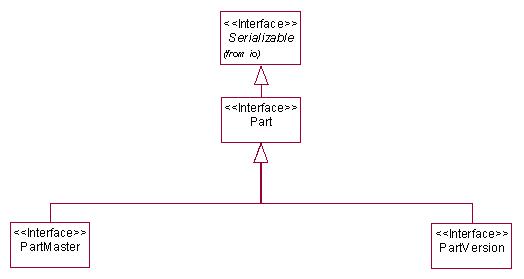Part Abstractions
The wt.part package provides a standard implementation of parts. A part is an item that can be produced or consumed, such as, an engine, a bolt, or paint. Parts can be assembled to produce other parts; for example, the drive train of an automobile can be thought of as a part composed of an engine, transmission, shaft, differential, and so on.
Design Overview
The following figure illustrates the basic concepts encapsulated by the Windchill part reference implementation.
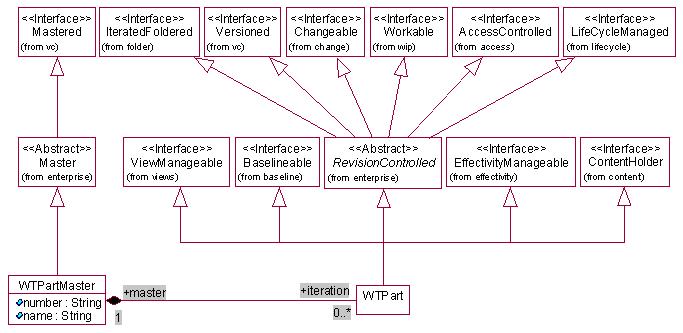
Part Reference Implementation
The part classes are implemented based on the pattern established for revision controlled objects in the wt.enterprise package. These classes, WTPartMaster and WTPart, provide concrete classes exhibiting the management characteristics established in wt.enterprise and add specifics for parts. The properties of a part are specified on the WTpart class. Then, for normalization purposes, the sum of the properties are stored on the WTPartMaster.
The part package is an example of implementing a Revision Controlled Business subclass. The concrete part business classes inherit from the Revision Controlled Business model (Master and RevisionControlled) template in the enterprise model. Part inherits most of its functionality from the enterprise object RevisionControlled. RevisionControlled pulls together the following plug and play functionality: Foldered, Indexable, Notifiable, DomainAdministered, AccessControlled, BusinessInformation, LifeCycleManaged, Version, Workable, and Changeable.
Attributes are on either WTPartMaster or WTPart. The WTPartMaster, as a Mastered object, represents the part’s identity. As such, "number" and "name" have been placed on it. The part’s number is the stamp the enterprise recognizes and uses for tracking purposes. The name is the human-readable component. These properties of the part are assigned carefully and rarely changed.
Attributes on WTPartMaster have the same value for all versions and iterations. If an attribute on the master changes after several versions and iterations have been created, the change is reflected in all the versions and iterations.
The WTPart, as a Versioned and Workable object, undergoes change that is recorded in its versions and iterations as a result of a check-out and check-in process. Attributes on WTPart can generally have different values for each iteration, so changes impact only one iteration.
An iteration occurs every time a part is checked out and in. It can be viewed as a working copy of the part. Iterations are assumed to happen many times between versions. Versions, however, represent a business increment; that is, an approved, major change to a part. A typical scenario is that version A of a part is approved and put into production. Then a change is determined to be necessary. The part goes through many iterations while the change is being investigated and tested. Finally, version B is approved.
Also, being ViewManageable, WTPart can be assigned to views, allowing it to progress through stages of development, such as engineering and manufacturing stages. It resides in folders, is subject to access control, progresses through life cycles, and is part of the change process as a consequence of being RevisionControlled. It can also be assigned to baselines to preserve a specific implementation and its versions can be made effective to indicate to a manufacturing process what to build.
Although shown in the preceding figure, WTPart is no longer a ContentHolder by default. The capability to hold files and URLs still exists, but it is no longer exposed to the user.
The WTPart also contains as aggregated properties a source and a type (as shown in the following figure).
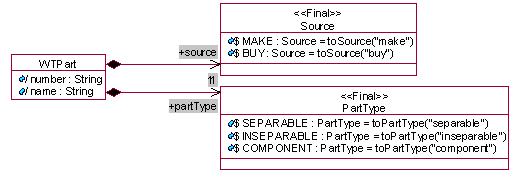
WTPart Properties
The source can be used to indicate how the part is procured, for example by being made or bought. The type specifies how it can be decomposed, for example by being separable (is assembled from components that can be taken apart to be serviced), inseparable (is assembled, but can not be disassembled), or component (is not assembled). The values of these properties can be altered by editing their resource bundles.
Also, note that number and name are modeled as derived and are implemented to set and get the real values from its WTPartMaster. The DerivedFrom property in the Windchill tab of the attribute specification has been used to indicate that it has been derived from the master’s attributes by specifying the database derivation; also, the getters and setters have been overridden in a manner similar to the following:
((WTPartMaster) getMaster()).get/set...(...)
WTParts can use other parts to build assemblies using the WTPartUsageLink as shown in the following figure.

Building Assemblies with the WTPartUsageLink
The WTPartUsageLink is a type of IteratedUsageLink, an association defined to be used to build structures. The WTPartUsageLink’s aggregated Quantity can be used to indicate the amount of the component that is being consumed. The QuantityUnit’s values can be altered by editing its resource bundle.
The WTPartUsageLink can be navigated using the PersistenceManager’s navigate APIs, or even the StructService’s navigateUses and navigateUsedBy APIs. Be aware that navigating the usedBy role results in the returning of all part iterations; StructService’s navigateUsedBy API returns only versions. However, the StructService’s APIs navigate using the IteratedUsageLink as its target; the WTPartUsageLink might not be the only IteratedUsageLink in a customization. We recommend using the APIs in the following figure.

Navigating the WTPartUsageLink
getUsesWTParts navigates to the WTPartMaster and resolves WTParts from the masters using a WTPartConfigSpec, returning a QueryResult of Persistable[]’s in which the WTPartUsageLink is in the 0th position and the WTPart/WTPartMaster in the first getUsesWTPartMasters simply navigates the WTPartUsageLink and returns a QueryResult of WTPartUsageLinks. Finally, getUsedByWTParts returns a QueryResult of WTParts (the versions, not simply all iterations) representing the implementations that call out the part.
WTParts can also reference documents (see the following figure).
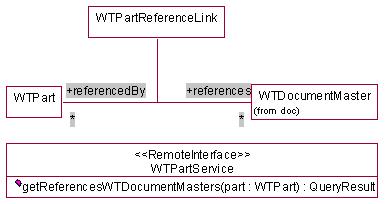
WTPartReferenceLink and Navigate API
Parts generally reference documents for one of two reasons:
• The part is not the logical owner of a document. An example of such a document is a standards document. A standards document is independent of a part, but may be used to verify conformance to the document.
• A document (file) is conceptually owned by the part, but must be separately life cycle managed, checked in and out independently of the file, and so on. Note that the WTPartReferenceLink may not be appropriate if the document’s versions are not necessarily interchangeable from the perspective of the WTPart. If a specific version of a document should be linked to a specific version of a part, use the DescribedBy link (as described later in this section) instead.
The WTPartReferenceLink can be navigated using the WTPartService’s getReferencesWTDocumentMasters API.
A WTPart can also be linked to a document that describes it on a version-specific level using WTPartDescribedByLink. An example of such a document is a CAD drawing that shows exactly how a specific version of a part is designed and should be built. If a change is made to the part and a new version created, the revised version of the CAD drawing, that reflects that change, should be linked to the new part using the DescribedBy functionality.
To summarize, a reference should be considered supplemental information that is useful but not required. It is likely to have its own life cycle and change independently of the part referencing it. A document linked to a part by a DescribedBy link contains information you may need specifically for that version of the part. A specific version of the document is linked to a specific version of the part.
The WTPartConfigSpec was alluded to by the getUsesWTParts API. It is used by the part structure during its navigations. It consists of three ConfigSpecs: the WTPartStandardConfigSpec, the WTPartEffectivityConfigSpec, and the WTPartBaselineConfigSpec (as shown in the following figure).
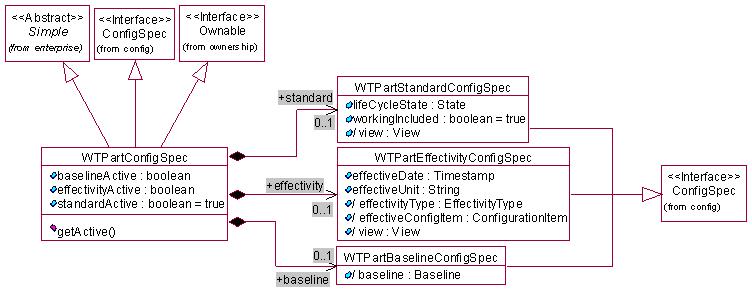
WTPartConfigSpec
A concept of zones has been added to the WTPartConfigSpec to determine which ConfigSpec is active at any given time. The WTPartConfigSpec is stored, one per principal, using the WTPartService’s APIs listed in the following figure.

Finding and Saving the WTPartConfigSpec
The ConfigSpecs aggregated by the WTPartConfigSpec have the following behavior:
WTPartStandardConfigSpec
When active, WTParts are filtered based on their state and their view membership. workingIncluded can be used to allow users to toggle between their working copies and their checked-out versions.
WTPartEffectivityConfigSpec
When active, allows the user to see structures based on effectivity and view. Only WTParts designated as effective are shown (see the wt.effectivity package for additional information).
WTPartBaselineConfigSpec
When active, displays only those WTParts assigned to the specified baseline (see the wt.vc.baseline package for additional information).
Parts can often be replaced by other parts, either globally or in the context of an assembly. This interchangeability is used to indicate that one part is equivalent to another in a given situation. The WTPartAlternateLink (shown in the following figure) is used to indicate global interchangeably, while the WTPartSubstituteLink indicates interchangeability within the context of an assembly. Note that the WTPartSubstituteLink is copied whenever the WTPartUsageLink is copied.
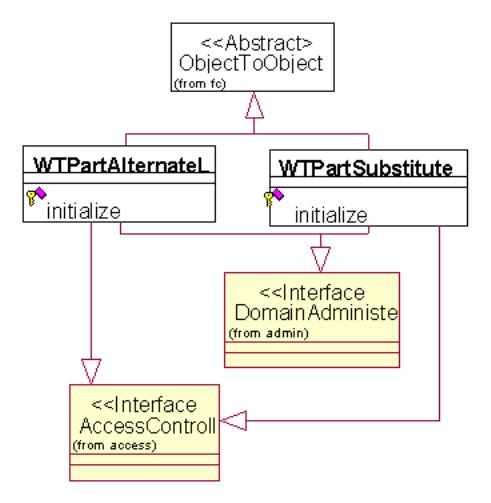
Alternate and Substitute Links
Both of these links can be navigated using the Persistence Manager’s navigate APIs. In addition, the WTPartService offers getAlternatesWTPartMasters and getAlternateForWTPartMasters methods for navigation of WTPartAlternateLinks and getSubstitutesWTPartMasters and getSubstituteForWTPartUsageLinks methods for navigation of WTPartSubstituteLinks. Both WTPartAlternateLinks and WTPartSubstituteLinks are access controlled, so permission to perform operations such as creation and deletion of links is defined using the access control service.
The Part, PartMaster, and PartIteration classes modeled in the wt.part package (see the following figure) are placeholders for future functionality.
